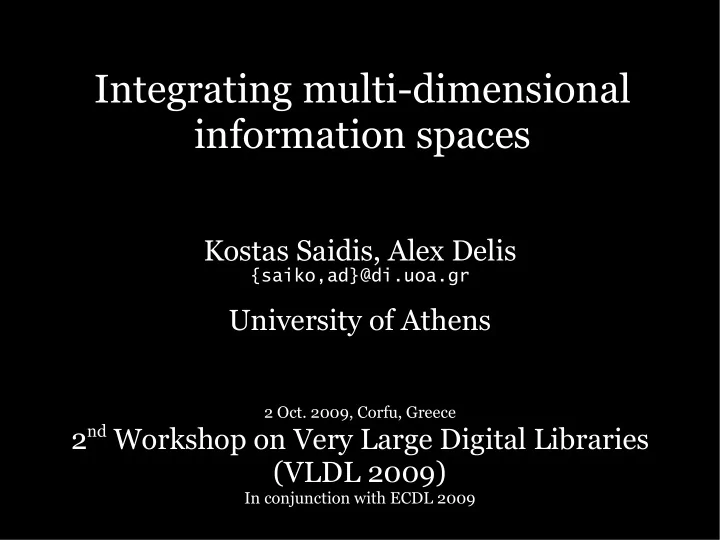

Integrating multi-dimensional information spaces Kostas Saidis, Alex Delis {saiko,ad}@di.uoa.gr University of Athens 2 Oct. 2009, Corfu, Greece 2 nd Workshop on Very Large Digital Libraries (VLDL 2009) In conjunction with ECDL 2009
Size does not matter (1) We view Very Large DLs as systems that manage not only “large” but also “complex” information spaces Diverse, multi-faceted content items: digitized and/or born digital intellectual works, institutional and/or personal archives, scholarly information, user-generated content Heterogeneous content sources: databases, XML repositories Plethora of applications, services, use-cases VLDL 2009 2
Our discussion Users need to share, reuse, refine and extend information in varying application contexts Can we supply VLDLs and related systems with a unified information space management infrastructure? Can this infrastructure add value by simplifying – and automating as highly as possible – the integration of diversely structured and heterogeneous information spaces? VLDL 2009 3
Diverse views of information Different systems develop different views of digital content for different purposes. Web pages, GUIs, Servicing etc View of Digital Content articles, books, Conceptual dissertations, etc View of Digital Content XML, datastreams, Physical/Storage databases, etc View of Digital Content VLDL 2009 4
Multi-dimensional Information Space Management Systems manage information in multiple dimensions, supporting diverse: Information identification & discovery options Information access options Information conceptualization options Information utilization options VLDL 2009 5
Integration as a process (roughly) 1.Discovery: systems “learn about” the existence of each other 2.Identification: systems unambiguously identify their individual items 3.Access: systems access their items 4.Utilization: systems synthesize their items VLDL 2009 6
Integration imposes extensions Realizing these steps requires dealing with a variety of information discovery, access, conceptualization and utilization options supported by involved systems Thus, when integrating information spaces, we practically need to extend involved systems in multiple crosscut and interdependent options Hard, cost-consuming, may require source-code modifications and/or system redesign VLDL 2009 7
Integration requires automation Information integration/interoperation is about “enabling information that originates in one context to be used in another in ways that are as highly automated as possible ” [The DOI Handbook, Edition 4.4.1, The International DOI Foundation] VLDL 2009 8
Time-out zzzzzzzzzzzzz I CORFU COFFEE BREAK NOW! VLDL 2009 9
Our point If we simplify the process of extending systems' multi-dimensional information management options We simplify the process of integrating their information spaces Simplify ~ automate as highly as possible VLDL 2009 10
WWW: the largest interoperable information space Automates information identification and access (HTTP & URIs) Yet: No built-in information discovery service (google) A single “document-based” conceptualization Information utilization follows a limited “publish/consume” paradigm Technologies such as Web Services & Semantic Web enhance limited information discovery, conceptualization and utilization options VLDL 2009 11
Size does not matter (2) Information integration/interoperation: plays a crucial role in smaller-scale information spaces, too: Digital libraries Business & Enterprise Environments Proprietary & Legacy systems etc is dominated by the information management options supported by involved systems VLDL 2009 12
VLDL 2009 13
Traditional Digital Library System VLDL 2009 14
Metadata Harvesting Application VLDL 2009 15
Application Independent Unified DL Infrastructure VLDL 2009 16
Infrastructure design (1) Content Source API: allow systems to operate atop multiple heterogeneous sources register new sources dynamically use a driver-based technique Content Access/Update API: read/modify actions that apply to any underlying content source VLDL 2009 17
Infrastructure design (2) Content Conceptualization API: support storage-independent, dynamic conceptualizations Employ an inheritance mechanism to enable refinement / extension of content items Content Discovery API: Provide 3 indexing/discovery facilities, for sharing: Content items, Content sources, Content conceptualizations VLDL 2009 18
</presentation> COFFEE BREAK NOW! VLDL 2009 19
Recommend
More recommend